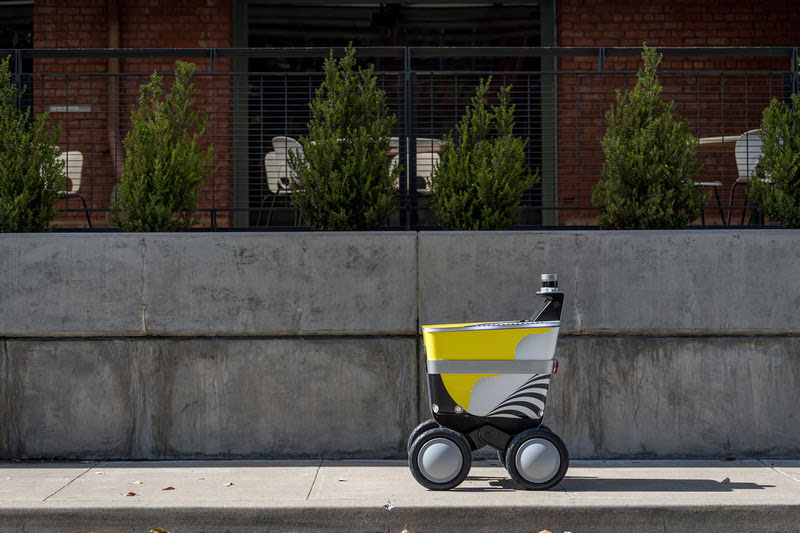Serve Robotics just raised $13 million in a seed extension round to grow its sidewalk delivery bot operations in new markets and with new partners.
The company was built inside Postmates under the company’s Postmates X division that explored cutting-edge technologies. When Postmates acquired a company called Lox in 2017, Dr. Ali Kashani came on board and brought degrees in computer vision and 3D imaging. He combined that with Postmates delivery data and co-founded the company’s robotics division. He said it was operations first for the adorable but uniquely rugged robots.
“At the time, Postmates looked at existing robotic efforts and realized that we could do it better, given the insights we had looking at the market data. Within a month, we were able to make a customer delivery. The commercial orientation was in our DNA; Postmates was a very operational company, so this was our DNA, too. In a couple years, we were operating a commercial fleet,” said Kashani. “There was a lot to learn there in the marketplace data. We were doing simulations on actual market data to build the product and answer questions like, ‘How much battery do we need? What level of autonomy do we need to achieve unit economics that will work?’ All of that fed into the product.”
The outcome was Serve, the brightly colored robot with much larger wheels and a suspension system or “bogie” mechanism that ensured better traction for the bots. He said that feature was essential so staffers didn’t have to drive around pulling robots out of holes or, someday, snowbanks.

Cofounder and CEO Ali Kashani.
“This sort of vehicle doesn’t exist today. When you start to look at the sidewalk, it’s not a friendly environment. There are tree roots, wells, construction—there is so much uncertainty. If you don’t have a robot that can deal with that, you have to deploy people to help the robots too frequently, which won’t be cost efficient,” said Kashani, Serve’s CEO. “We joke around, but we’ve interacted with goats on the sidewalk; things you never would imagine would happen do happen. There are elements of the environment that are completely out of your control, such as network quality, infrastructure, etc.”
Where other robotic delivery companies focus on campuses and controlled environments as a foundation, the real world is a bigger challenge.
“We had the benefit of being in a larger organization, and we decided to solve the larger problem,” said Kashani.
The fleet carried out more than 10,000 orders during the COVID-19 pandemic with 100 different partners. So far, the robots are only in the Los Angeles, with some limited numbers in the San Francisco Bay Area. That was a great validator for the company, but then came the Uber acquisition.
Success going solo
To an outsider, it might seem like Uber acquired Postmates and simply spun Serve Robotics out onto the cold, bumpy and goat-infested sidewalk, but Kashani said he was already planning to emerge from the corporate umbrella.
“I had been working on spinning Serve out of Postmates before the acquisition. So, this was an initiative from the Serve team. We recognized that for us to be inside a larger organization, it limits our market reach,” said Kashani. “We want to go work with everyone, including Uber competitors. If we are inside another organization, we are leaving most of the market for competitors. That means they get better economies of scale; it didn’t seem like the best way to approach it.”
The spinoff was completed in March 2021, a few months after the acquisition. The $13 million seed round is the first strategic investor financing for the company and brings some familiar robotics leaders into the mix, including former owner Uber and Delivery Hero.
“We are just very lucky, we have Uber and Delivery Hero, they’re two of the largest food delivery platforms in the world. And of course, 7-Eleven, which is an international chain,” said Kashani.
He’s eager to meet the international demand from both 7-Eleven and Delivery Hero, but there is plenty to do in the U.S. as well. Wavemaker, the investment firm behind Flippy and Nommi is also in the mix, CEO Buck Jordan said it’s another step in the automated restaurant.
“Serve Robotics has built a highly advanced, self-driving delivery robot that delivers safely and reliably for merchants,” said Jordan, founder and CEO at Wavemaker Labs in a statement. “We look forward to using autonomous delivery to elevate the customer experience and improve the unit economics of our food automation brands.”
DX Ventures, Neo, Western Technology Investment and investor Scott Banister also joined the round. Kashani said it shows there is plenty of appetite for robotic delivery, even if some of the hype has died down.
“We’re at the intersection of self-driving and on-demand delivery. Both of these sectors have gone through these cycles—a lot of excitement, then a lot of skepticism, then consolidation. For self-driving, there was a promise. It turned out to be harder than a lot of people thought, but now there’s a lot of activity,” said Kashani. “We’re finding the places in the market where the technology is much closer to commercialization. It’s this really interesting intersection, both of these domains are super exciting and I feel like we’re reaching this point of convergence for the real market appetite.”
The appetite will bring Serve to “multiple major cities” in the U.S. next year, with an eye on areas of labor difficulty and projected high utilization of the bots—a key factor for keeping robotic delivery profitable. Kashani said the funding will also go toward hiring engineers and bulking up the sales and account teams to make it easier for partners to figure out how to approach robotic delivery.


